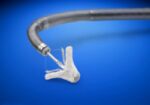Severe mitral regurgitation is three times more prevalent than aortic stenosis in the elderly population at high risk and poor prognosis if not treated. Fortis mitral valve was designed using several preclinical models and are now tested for the first time in 4 patients resulting in various technical difficulties and finally the death of 3...
Percutaneous mitral valve treatment is a valid alternative in the long term
Original title: 4-Year Results of a Randomized Controlled Trial of Percutaneous Repair Versus surgery for Mitral Regurgitation. Reference: Laura Mauri, et al. J Am Coll Cardiol 2013;62:317-28 Surgical treatment of mitral regurgitation (MR) is currently recommended by either valve replacement or valvuloplasty. Devices are being developed to address this disease giving the benefits of percutaneous treatments. The EVEREST...
Is High Mean Gradient After Edge-to-Edge Strategy Important?
Edge-to-edge treatment of the mitral valve is currently a valid alternative to surgery in cases of mitral regurgitation. Different studies have taken residual mitral regurgitation as a parameter of success, but little research has been conducted on the residual gradient once the procedure has been completed. What has been published is that a mean gradient...
The Ten Commandments in Adult Congenital Heart Disease
Adult congenital heart disease is a life-long condition that requires appropriate follow-up by experts. Said follow-up is paramount to diagnosing specific and highly variable complications in a timely manner. The recently published European Society of Cardiology guidelines for the management of congenital heart disease calls for a summary of its most important aspects as “ten...
Constrictive Pericarditis After Pericardiocentesis
All interventional cardiologists must be able to perform a pericardiocentesis. Whether we deal with a chronic total occlusion, a supposedly simple coronary angioplasty (we all have witnessed the perforation of a supposedly risk-free coronary artery), or a transcatheter aortic valve replacement (whose rise gave us another significant source of tamponades), we must all be ready...
Stroke, Migraine and Patent Foramen Ovale Not Necessarily Temporary Associated
Cryptogenic stroke patients with migraine have high prevalence (79%) of patent foramen ovale (PFO) with right to left shunt. However, the timing of stroke in migraineurs is not usually associated to a migraine attack. These observations are consistent with the hypothesis that the most likely mechanism of stroke in these patients with migraine is a...
Diastolic Dysfunction: Shall We Begin to Assess It?
Courtesy of Dr. Carlos Fava. The association between diastolic dysfunction (DD) and aortic insufficiency (AI) after transcatheter aortic valve replacement (TAVR) has not been studied yet, but the presence of aortic regurgitation has proved to be associated with worse outcomes. A total of 144 out of 195 patients who underwent TAVR with balloon-expandable SAPIENS or SAPIENS XT...
Mitraclip® year results
Original title: Residual Mitral Valve Regurgitation After Percutaneous Mitral Valve Repair with Mitraclip® System in a Risk Factor of Adverse one-Year Outcome Reference: Liliya Paranskaya et al. Catheterization and Cardiovascular Intervention 81:609-617 (2013). Currently, the gold standard for the treatment of mitral regurgitation (MR) is surgery but 20% of patients are rejected because they present a high surgical...
Transcatheter Myotomy for the Treatment of the Dynamic Obstruction of the Left Ventricular Outflow Tract
Septal reduction therapies are used to mitigate the symptoms caused by dynamic left ventricular outflow tract (LVOT) obstruction and the associated mitral regurgitation (MR) that can surge in hypertrophic cardiomyopathy (HCM). Alternative therapies to treat LVOT obstruction include surgical procedures, i.e. surgical myotomy or myomectomy, or alcohol and radiofrequency septal ablation (intracardiac, transthoracic and endocardial,...
Edge-to-Edge Repair in Cardiogenic Shock
The edge-to-edge approach with MitraClip has been established as a valid strategy for patients who experience severe symptomatic mitral regurgitation (MI) with high risk for surgery, currently with a IIa indication. MI complicated by cardiogenic shock, which results in a high risk for conventional valve surgery, is a particularly complex scenario. In such a case,...









